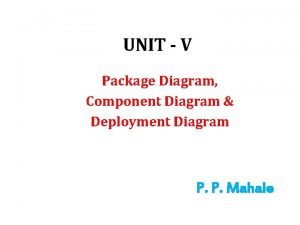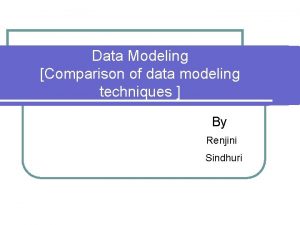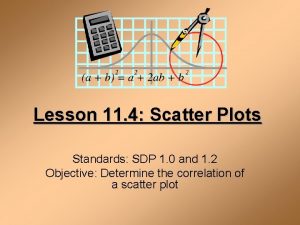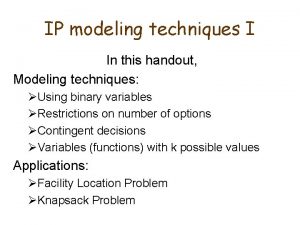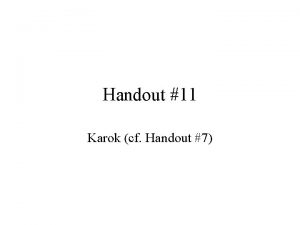IP modeling techniques II In this handout Modeling












- Slides: 12

IP modeling techniques II In this handout, Modeling techniques: ØEither-Or Constraints ØBig M method ØBalance constraints ØFixed Charges Applications: ØMulti-period production planning ØInventory management

Modeling technique: Either-Or Constraints • In some situations, a choice can be made between two constraints, so that only one (either one) must hold whereas the other one can hold but is not required to do so. • E. g. , recall the capacity constraints for the furniture manufacturer example: pine: 5 xt + 1 xc + 9 xd 1500 (1) oak: 2 xt + 3 xc + 4 xd 1000 (2) Suppose the furniture can be made from either pine or oak but we don’t need both. How to achieve that in the model?

Either-Or Constraints • Introduce new binary variables. For i=1, 2 • Only one of (1) and (2) must hold. Thus, add a constraint: y 1+y 2 = 1 • We also need: y 1=1 implies 5 xt+1 xc+9 xd 1500 y 2=1 implies 2 xt+3 xc+4 xd 1000 How to express these implications by linear constraints?

Either-Or Constraints Ø New idea: use the big number method. • Select a huge positive number M. • Note that 5 xt+1 xc+9 xd 1500+M holds for any reasonable choices of xt, xc, xd. It is equivalent of not putting any restriction on xt, xc, xd at all. • Consider constraint 5 xt+1 xc+9 xd 1500+M(1 -y 1) (3) – If y 1=1 then (3) is equivalent to (1) – If y 1=0 then (3) doesn’t impose any restriction on xt, xc, xd • Thus, the set of constraints 5 xt+1 xc+9 xd 1500+M(1 -y 1) 2 xt+3 xc+4 xd 1000+M(1 -y 2) y 1+y 2 = 1 provides that only one of 5 xt+1 xc+9 xd 1500 and 2 xt+3 xc+4 xd 1000 must hold.

k out of p constraints must hold • Suppose the model includes a set of p constraints f 1(x 1, x 2, …, xn) d 1 f 2(x 1, x 2, …, xn) d 2. . fp(x 1, x 2, …, xn) dp such that only some k of these constraints must hold. • Generalizing the big M method of the previous slide, that condition is achieved by the following set of constraints: f 1(x 1, x 2, …, xn) d 1+My 1 f 2(x 1, x 2, …, xn) d 2+My 2 …. fp(x 1, x 2, …, xn) dp+Myp y 1+y 2+…+yp = p – k y 1, y 2, …, yp binary

IP modeling: Multi-period production planning • A manufacturer wishes to schedule production for K periods in advance to meet known monthly demands for a given product. • Demand for period i is Di. • In period i, at most Ci items can be produced at cost $pi per item. • The demand of the current period can be satisfied by the items produced in earlier production periods (aka inventory). • The cost of holding an item in inventory from period i to period i+1 is $hi. • No inventory at the beginning of the first period. At most Hi items are allowed in inventory at the beginning of period i. • Goal: Formulate an IP which will minimize the total cost while satisfying the demands.

IP modeling: Multi-period production planning • What variables should we have? Define xi = number of items produced in period i , for i=1, . . . , k. wi = number of items in inventory at the beginning of period i , for i=1, . . . , k+1. (xi and wi are nonnegative integers) • What is the objective function? Minimize the total production and inventory cost: • Some obvious constraints. Production limit: xi Ci , for i=1, . . . , k Inventory limit: wi Hi , for i=1, . . . , k+1 No inventory before period 1: w 1 = 0

Multi-period production planning: Balance Constraints • Also need constraints satisfying the demands, and relating xi and wi. • Consider the following diagram for period i: wi INPUT xi Di Period i wi+1 OUTPUT • The corresponding constraint for period i (i=1, …, k): wi + xi = Di + wi+1 This is known as balance constraint, and is often used in multi-period problems. Note that the balance constraints provide that wi + xi ≥ Di (since wi+1 ≥ 0), and thus the demands are satisfied.

Multi-period production planning: Complete IP model s. t. xi Ci , wi Hi , wi + xi = Di + wi+1 , w 1 = 0 xi ≥ 0 integer wi ≥ 0 integer for i=1, . . . , k+1 for i=1, …, k for i=1, . . . , k+1

Multi-period production planning: Fixed Setup Cost • Note that the demand of the current period can be totally satisfied by the inventory carried from the previous period. • Suppose there is a setup cost $si for period i if we decide to have any production for that period (and there is no setup cost if there is no production). • How to take the setup costs into account? • We need a new entry in the objective function: if xi>0 then si for each period i. But this is not a linear function (because no conditions are allowed on variables).

Multi-period production planning with setup cost • To overcome the problem, introduce new variables. For i=1, . . . , k, • Then the setup cost is siyi for period i. • But we also need new constraints relating xi and yi. • Idea: Use the big M method. For each i=1, . . . , k , add a constraint xi Myi. Why does it work? § If yi=0 then xi must be 0; § If yi=1 then there is no restriction on xi. • Note that we can take M=Ci for period i. Thus, we don’t need new constraints. Simply, replace xi Ci with xi Ciyi. • Question: Can we have yi=1 but xi =0 for period i ?

Multi-period production planning with setup cost • Summarizing, the modified IP model is: s. t. xi Ciyi , wi Hi , wi + xi = Di + wi+1 , w 1 = 0 xi ≥ 0 integer wi ≥ 0 integer yi binary for i=1, . . . , k+1 for i=1, …, k
 Modeling role modeling theory
Modeling role modeling theory Relational modeling vs dimensional modeling
Relational modeling vs dimensional modeling Common modeling techniques of deployment diagram
Common modeling techniques of deployment diagram Idefix notation
Idefix notation Aquamatic k pad
Aquamatic k pad Scatter plots and data student handout 4
Scatter plots and data student handout 4 Handout definition
Handout definition Lee silverman voice technique
Lee silverman voice technique Spinal precautions blt
Spinal precautions blt Fire extinguisher training handout
Fire extinguisher training handout Was ist ein handout bei einer präsentation
Was ist ein handout bei einer präsentation Handout 5-2 graphic organizer the brain answers
Handout 5-2 graphic organizer the brain answers Dysphagia diet levels handout
Dysphagia diet levels handout


